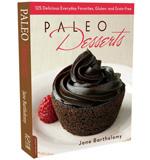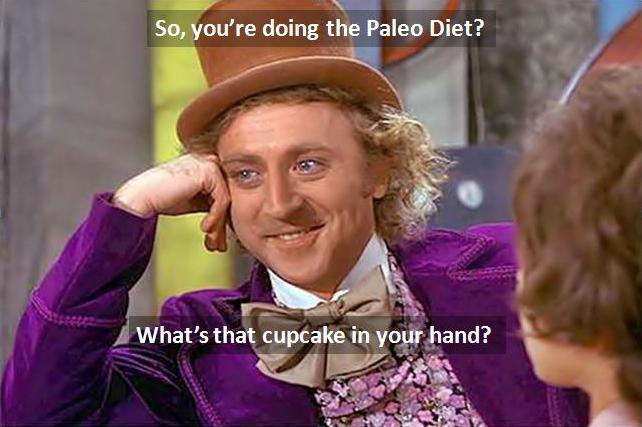By Jane Barthelemy.
As interest in the Paleo Diet grows exponentially, it is evolving into more of a Lifestyle than a Diet. When people ask: “What are the Pros and Cons of Paleo?” I say that it depends on your personal interpretation. Many popular authors advocate different versions of the ancestral diet. For some it’s a low-carb diet. Others say it means no grains or dairy. Many ask: How many calories, carbs, fat, and protein should I eat? How strict do I have to be? Is an occasional cupcake permitted?
It’s clear the modern American diet is part of the problem in our epidemic of disease: obesity, diabetes, cancer, and heart disease. The Paleo Diet mimics the wild food diet of our ancestors. It was fresh and alive, free of industrial chemicals, processed carbs, refined sugar, preservatives, and junk food. As our health awareness grows, the true Paleo diet looks more and more appealing. It invites us to eat the old-fashioned hunt & gather way – i.e. wild animal protein and plants. (My book Paleo Desserts shows how to make all your favorite sweets – including cupcakes – using hunt & gather ingredients.) In case you’re new to the discussion, here’s a pictorial image of the Paleo diet.
Pros of the Paleo Diet:
1. The approach is simple: there is no weighing, measuring, or portion control. What a relief! And Paleo is relatively easy to order in most restaurants, if you stick to a salad with no dressing, an entrée of non-gmo meat, chicken or fish, and vegetables. Oh, and skip dessert.
2. The Paleo diet says NO to the worst offenders: refined sugar, dairy, legumes and grains, adhering to a pre-agricultural, hunt and gather food plan. It says YES to meat, fish, poultry, fruits, veggies, nuts, seeds and fats. This is a huge step toward health for most people.
3. Paleo is a gift for those of us on special diets, including diabetic, gluten free, dairy-free, sugar free and additive-free. It balances the metabolism because there is no sugar rush and subsequent energy drop. Many people lose weight on the Paleo diet – Protein, fiber and fats help you feel satiated and energized. The Paleo lifestyle emphasizes fitness, movement, sleeping well and maintaining energy levels.
3. There are no empty calories – the diet is nutritionally dense and there are no chemicals to trigger cravings. One small study of 29 participants published in Nutrition and Metabolism in 2010 found Paleo dieters felt just as full but consumed fewer calories than their Mediterranean counterparts.
4. Improved health markers. Many people find the Paleo Diet dials down the chronic inflammation that causes their allergies, joint pain, insomnia, migraines, autoimmune disorder and diabetes. Taking dairy, sugar and carbs out of their diet allows blood sugar to stabilize and decreases the cortisol and sugars that ignite inflammation.
5. Weight Loss & Higher Energy Levels. Most people on the Paleo Diet report that they lose weight and experience higher energy levels. They feel younger and enjoy life more fully. If you’re in good health and want to keep it that way, take a nod from your ancestors. The high quality, nutrient-dense foods in the Paleo Diet – plus no refined ingredients – can help maintain and increase your vitality. With NO cupcakes, that is.
6. It puts you squarely in control of your health and diet. In the final analysis, healthy eating means becoming sensitive to what your body wants, and this is different for each person. The responsibility is 100% yours, and this is as it should be.
Cons of the Paleo Diet:
1. It can be expensive. Grass fed meats and organic vegetables are more costly. However giving up prepared foods that are nutritionally empty may compensate for the extra expense.
2. Restrictive for children? Sally Fallon of the Weston A. Price Foundation has criticized the Paleo diet as too restrictive socially and nutritionally for children. She also takes issue with the assertion that cereal grains and potatoes were unavailable to early humans, citing archeological evidence. While she acknowledges that “many people do poorly on grains,” she doesn’t see any reason to restrict them entirely. Read more.
3. The Paleo Diet Doesn’t include fermented dairy or sprouted grains, despite the fact that fermented and sprouted foods were a tradition in ancient societies, Paleo does not recognize their benefits. Fermenting and sprouting increases the life force in foods, including the nutrient value and digestibility. Instead, the Paleo Diet categorically bans all dairy and grains. That’s a big reaction. Could it be an understandable overreaction to our modern mis-handling of dairy and industrial grains?
4. The Paleo Diet is difficult to adopt and stick to. Some people find it hard or impossible to give up grains, beans, and sweets. It takes discipline, especially when other family members are unsupportive. Eating with friends and relatives can be a mine field of temptations and challenges. The Paleo Diet demands on-going commitment. Some Paleo adherents become so extreme and radical that it causes stress in their lives and the lives of the people around them.
5. The Paleo Diet is controversial. In the final analysis, Paleo means ending your relationship with addictive foods, starting with sugar, refined carbs, alcohol and food additives that aren’t food at all. Well, we all know some people won’t give up their vices easily. However, once these stressful addictions/desires are removed from the body, you can really sense and feel what’s right for YOU on a given day.
6. It is too easy to cheat on the Paleo Diet. Some Paleo leaders say “Go 80% Paleo and you’re good”, ergo the occasional cupcake. However this can create a pattern of cheating. OK, but if you eat junk food the other 20% of the time, you’re defeating the whole purpose.
7. The Paleo Diet is so flexible, it can be misinterpreted & misused to your detriment. Since there are few guidelines, other than foods to eat and foods to avoid, some people don’t eat what’s right for them. To some, it’s a high protein diet. Others are Paleo-vegetarian. Some overload on protein, others on fat, or carbs. You can actually be addicted to sweet foods and still be Paleo, according to conventional wisdom. Over time, the Paleo Diet has been interpreted to include foods that are not Paleo. Some suggest coffee as Paleo, although it was not consumed until 900 CE. Most Paleo cookbooks (mine is an exception) use high-carb sweeteners such as maple syrup and coconut sugar, both highly processed and addictive. Honey is a true Paleo sweetener, but it is loaded with fructose sugar that can be detrimental to your health. So it is possible for a person to follow the conventional Paleo diet and still show up with all the markers for the Standard American Diet – caffeine stress, sugar addiction, and all the diseases that go along. It’s all about how you interpret the diet.
8. Is there too much fat on the Paleo Diet? Meat during that period was wild – and as a result it was much leaner and lower in fat than our domestic cattle. Cholesterol and fat are not a problem for Paleo followers, but the jury is out on how much is too much.
9. Is it realistic? Many people remind us the life expectancy in the Upper Paleolithic was 33 years – not a compelling health reason to follow the diet. However studies show that early humans were more likely to die from being eaten by a tiger or starvation, rather than from modern diseases such as obesity or diabetes.
Is Paleo the best diet for humans? Yes, it is for some people. In the final analysis, no one knows better than you. If you have the courage and desire, take the Paleo Challenge – try it for 30 days. Listen to your body, experiment to find the best diet for you. Check out my book Paleo Desserts for low-carb healthy treats without deprivation. Take every opportunity to build true health.
* What are Paleo Foods?
Paleo foods contain no refined or processed ingredients, no gluten, grains, dairy, or sugars. It excludes agricultural ingredients and any foods that did not exist during Paleolithic times. There are no alcoholic beverages, soft drinks, artificial sweeteners, potato chips, bread, coffee. Paleo means no sweet fruits, such as bananas, mangoes, pineapples, grapes, mulberries, or fruit juices. The Paleo Diet bans all dairy, including milk, cream, yogurt, and cheese. Legumes are out, including beans: kidney beans, pinto beans, soy, tofu, and soy milk. The diet also bans Omega 6 oils and extracted vegetable oils, such as corn, soy, canola, safflower, sunflower.






No Replies to "Pros & Cons of the Paleo Diet"